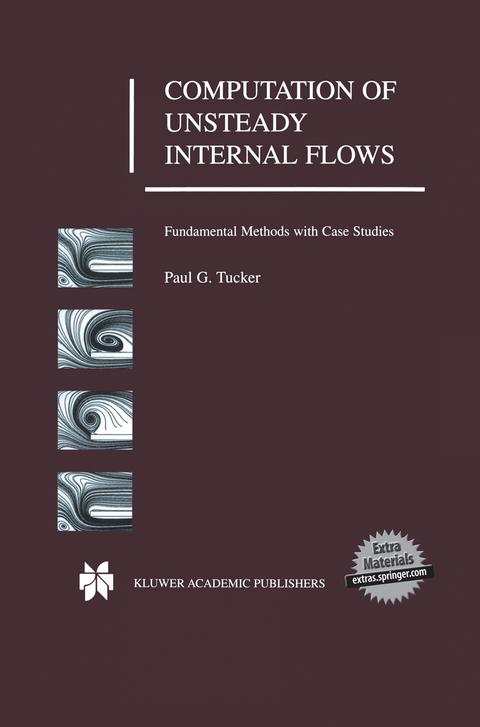
Computation of Unsteady Internal Flows
Springer (Verlag)
978-0-7923-7371-1 (ISBN)
Features of Computation of Unsteady Internal Flows: Specialized unsteady flow modeling algorithms, their traits, and practical tips relating to their use are presented.
Computation of Unsteady Internal Flows provides an in-depth understanding of unsteady flow modeling and algorithms. This understanding enables suitable algorithms and approaches for particular fields of application to be selected. In addition, the understanding of the behavior of algorithms gained allows practitioners to use them more safely in existing codes, enabling meaningful results to be produced more economically.
Features of Computation of Unsteady Internal Flows: Specialized unsteady flow modeling algorithms, their traits, and practical tips relating to their use are presented.
Case studies considering complex, practically significant problems are given.
Source code and set-up files are included. Intended to be of a tutorial nature, these enable the reader to reproduce and extend case studies and to further explore algorithm performances.
Mathematical derivations are used in a fashion that illuminates understanding of the physical implications of different numerical schemes. Physically intuitive mathematical concepts are used.
New material on adaptive time stepping is included. £/LIST£ Audience: Researchers in both the academic and industrial areas who wish to gain in-depth knowledge of unsteady flow modeling will find Computation of Unsteady Internal Flows invaluable. It can also be used as a text in courses centered on computational fluid dynamics.
1 Introduction.- 1-1 The Importance of Modelling Unsteady Flows.- 1-2 The Nature and Causes of Unsteadiness.- 1-3 Flow Equations, their Mathematical Nature and Physical Implications.- 1-4 Summary of Book Content.- 2 Overview of Elementary Temporal Discretizations.- 2-1 Introduction.- 2-2 Profile Assumptions for Variables.- 2-3 The Generic Discretized Equation.- 2-4 Two-level Schemes.- 2-5 Three-level Schemes.- 2-6 Predictor-Corrector Methods.- 2-7 Splitting Methods.- 2-8 Time Marching and Stiffness.- 2-9 Characterizing Stability and Accuracy of Schemes.- 2-10 Boundary Conditions and Solution Initialization.- 2-11 Integration of Particle/Droplet Transport Equations.- 2-12 Two-level Scheme Exemplar.- 2-13 Conclusions.- 3 Temporal and Spatial Discretization Relationships.- 3-1 Introduction.- 3-2 The Substantial Derivative.- 3-3 Convective Term Treatments.- 3-4 Dissipation, Dispersion.- 3-5 Moving Boundaries.- 3-6 Time Adaptive Solutions.- 3-7 Conclusions.- 4 Solver Algorithms and General Solution Procedures.- 4-1 Introduction.- 4-2 Simultaneous Equation Solvers.- 4-3 Parallel Processing.- 4-4 Evaluation of the Pressure Field.- 4-5 Review of Commercial Programs and their Unsteady Flow Capabilities.- 4-6 Features of Codes used for Case Studies.- 4-7 Conclusions.- 5 Solution Adapted Time-Steps.- 5-1 Introduction.- 5-2 Numerical Methods.- 5-3 Discussion of Results.- 5-4 Conclusions.- 6 Turbulence Modelling.- 6-1 Introduction.- 6-2 VLES/URANS Modelling.- 6-3 LES Modelling.- 6-4 Zonal LES/DES.- 6-5 URANS Models used in Case Studies.- 6-6 Conclusions.- 7 Cyclic Annular Cavity Flows.- 7-1 Introduction.- 7-2 Numerical Details.- 7-3 Discussion of Results.- 7-4 Conclusions.- 8 Cyclic Aero Engine Motivated Cavity Flows.- 8-1 Introduction.- 8-2 Numerical Details.- 8-3 Lower Reynolds Number Results.- 8-4 Higher Reynolds Number Results.- 8-5 Adaptive Time Stepping.- 8-6 Conclusions.- 9 Cyclic Moving Boundary Flows.- 9-1 Introduction.- 9-2 Numerical Details.- 9-3 Discussion of Results for Journal Bearing.- 9-4 Discussion of Results for Magnetic Bearing.- 9-5 Conclusions.- 10 Cyclic Complex System Flow.- 10-1 Introduction.- 10-2 Numerical Details.- 10-3 Discussion of Results for Fluid Flow.- 10-4 Adaptive-Time Stepping.- 10-5 Discussion of Results for Scalar and Particle Transport.- 10-6 Conclusions.- 11 Transient Complex System Flow.- 11-1 Introduction.- 11-2 Numerical Details.- 11-3 Discussion of Results.- 11-4 Conclusions.- 12 Overall Conclusions with Future Perspectives.- Appendices.- A Discretization of The Governing Equations and Multilevel Convergence Operators.- A-l General Equation Discretization.- A-2 Treatment of Variables at the Axis of Rotation.- A-3 Discretization of Earth’s Acceleration Due to Gravity.- A-4 The Multilevel Restriction and Prolongation Operators.- B Derivation of Condif Scheme for Variable Density Fluid.- C Multilevel Convergence Performance Exemplars.- C-l Driven Box Flow.- C-2 Grid Embedding.- C-3 Cluttered Geometries.- C-4 Grid Aspect Ratio.- C-5 Heated Rotating Cavity Flow.- C-6 Conclusions.- D Further Chapter 10 Case Details.- E FLO_CAV Program User Information.- E-l FLO_CAV Program.- E-2 Description of Program Structure and Subroutines.- E-3 Program Input.- E-4 Boundary Conditions.- E-5 Post processing.- F FLO_BEARING Program User Information.- F-l FLO_BEARING Program.- F-2 Description of Program Structure and Subroutines.- F-3 Program Input.- F-4 Boundary Conditions.- F-5 Input Files.- G FLO_ELEC Program User Information.- G-l FLO_ELEC Program.- G-2 Description of Program Structure and Subroutines.- G-3 ProgramInput.- G-4 General Details.- References.
| Zusatzinfo | XVIII, 355 p. |
|---|---|
| Verlagsort | Dordrecht |
| Sprache | englisch |
| Maße | 155 x 235 mm |
| Themenwelt | Naturwissenschaften ► Physik / Astronomie ► Mechanik |
| Naturwissenschaften ► Physik / Astronomie ► Strömungsmechanik | |
| Technik ► Maschinenbau | |
| ISBN-10 | 0-7923-7371-5 / 0792373715 |
| ISBN-13 | 978-0-7923-7371-1 / 9780792373711 |
| Zustand | Neuware |
| Haben Sie eine Frage zum Produkt? |
aus dem Bereich


